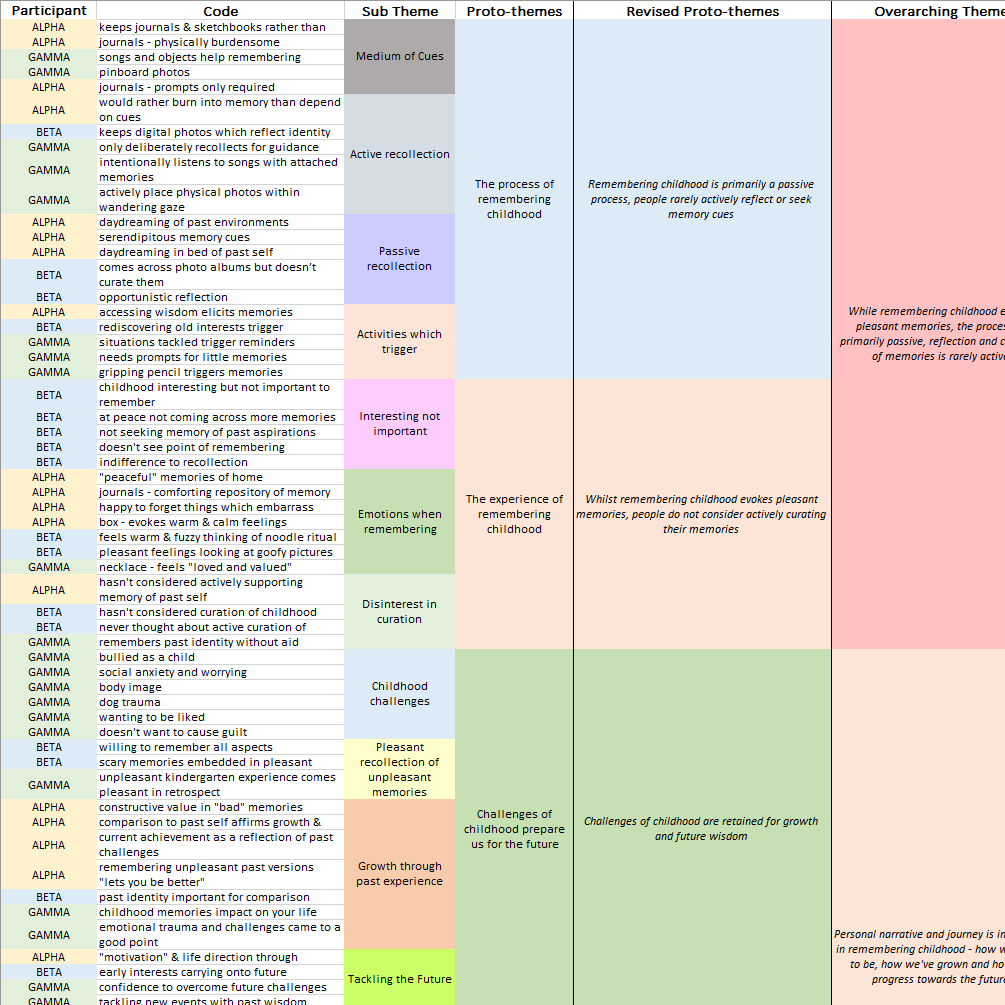Remembering Childhood
UX Research Project
Over the course of three months, I performed a two-part qualitative research study into understanding the significance of childhood memories in young adults.










Overview
Using Human-centred design methods, perform research into the memories and associated memory cues that people have with a past time or repeat event.
Assessment
My research question
What aspects of childhood & childhood identity do people find significant and meaningful? What memories and memory cues do people associate with such period?
My role
This project was completed individually with guidance from academic staff.
I conducted mixed-method qualitative design research, applying methods such as contextual inquiry, inductive coding and design probes to stimulate discussion and understanding of my chosen topic.
Outcomes
I produced a research poster, a video and research paper discussing my process and the insights revealed from my research.
Part 1: User Interviews & Poster
Three participants were recruited for this study. Each participant brought 2 - 3 objects which had a significant role in their childhood, as stimulus for discussion.
Across three interviews, 1 h 51 m 04 s of audio was recorded and manually transcribed into 12,782 words.
Transcripts were scanned using ‘inductive coding’ to produce 147 ‘codes’.
Codes were processed through several rounds of affinity mapping and distilled down to 6 themes.
Memory Cues - Objects which trigger memories








Insights
While remembering childhood evokes pleasant memories, the process is primarily passive, reflection and curation of memories is rarely active
“It’s more often I’m like lying in bed […] so if I’m going to remember it’s going to be from going down a thinking hole”
Personal narrative and journey is important in remembering childhood how we came to be, how we've grown and how we progress towards the future
“I am thinking about the people that were there and everything that went into bringing me here, that motivates me to keep going…to reflect that work”
Whether aspects of childhood are still present and used today affects the significance we place on them.
“I don’t have the person, but I have the thing they were”
Although we value periods of stability and repeat interaction with others, it is the major events & changes that highlight and demarcate childhood.
“Starting school, getting through kindergarten and all that. I really remember that period which is odd”
The role of others is crucial in what and how we remember our childhoods.
“Every time they talk about my childhood they are like ‘Remember Little Ted, he was always there’”
Childhood hobbies and abilities are important to remember and desirable to carry on
“I just remember being fascinated by the clay […] and that is actually a big foundation for what I do, actually who I am today” Discussion
Part 2: Design probe, user interview & video.
I wanted to know more about the insights of personal narrative, hobbies and journey.
To inquire deeper, I created a bespoke ‘design probe’ - a tool to stimulate and engage more personally with a previous participant.
The design probe contained tasks for the participant to complete over a period of two weeks.
At the completion, the contents were examined and served as a stimulant for a follow-up interview.








